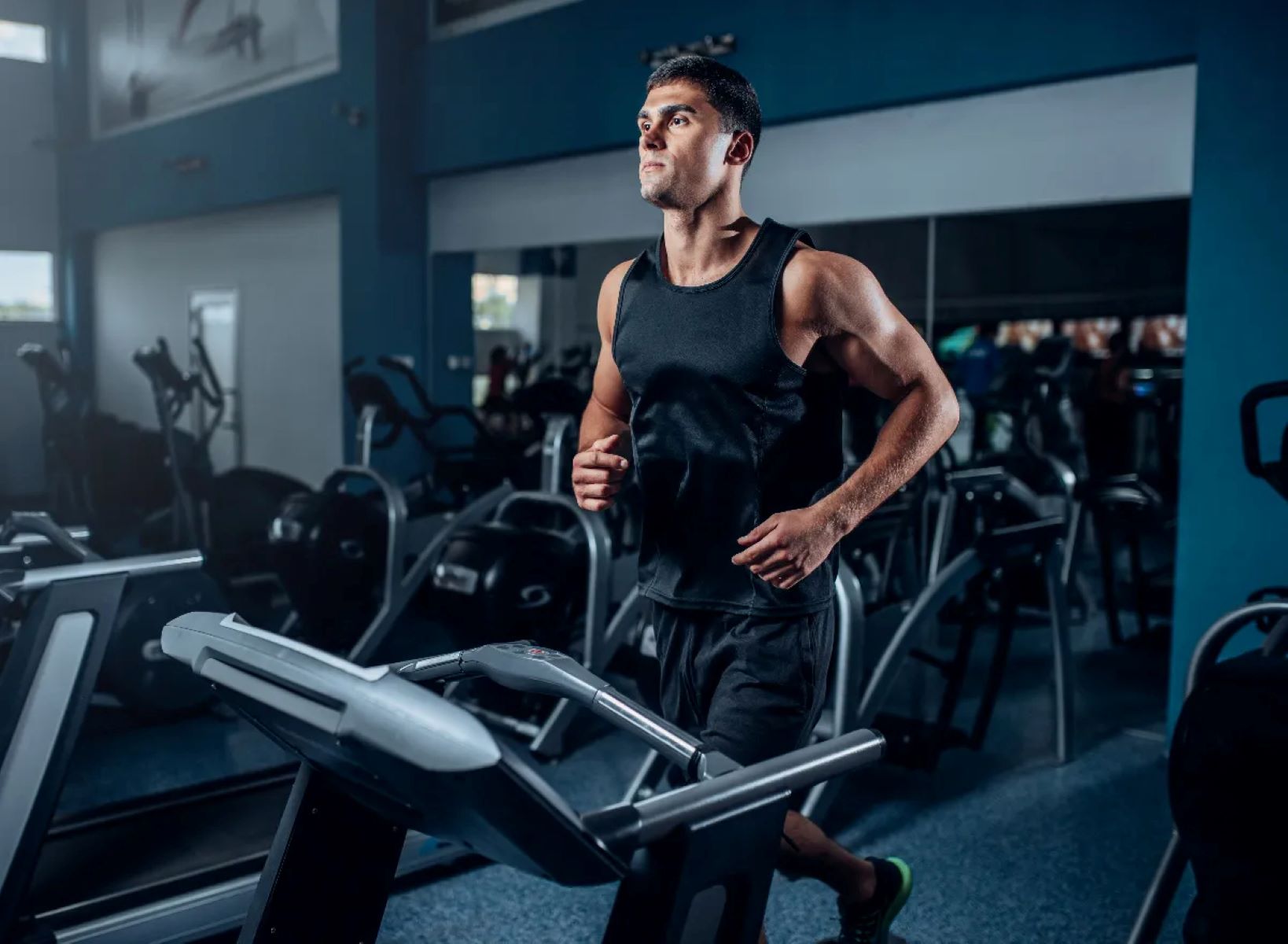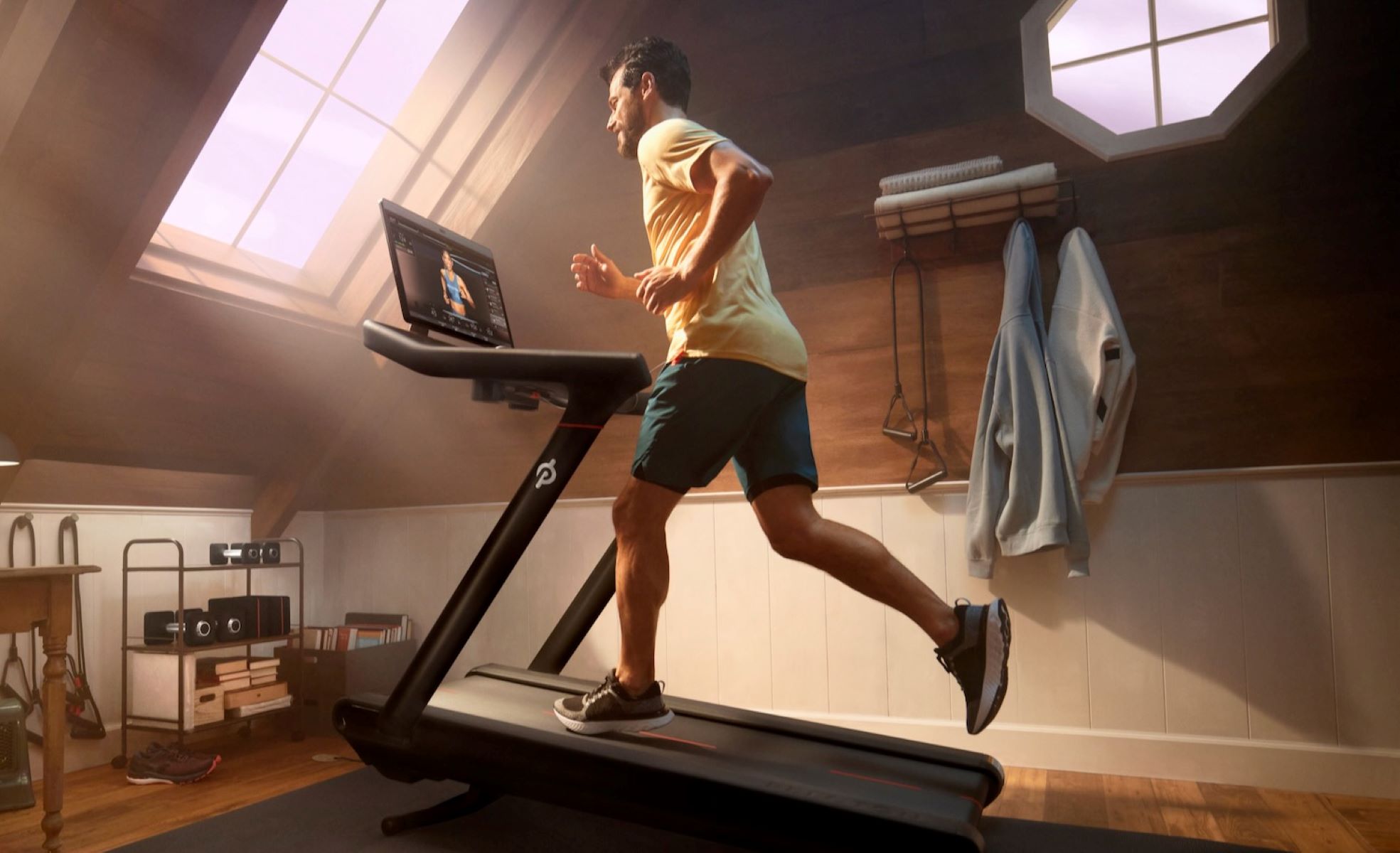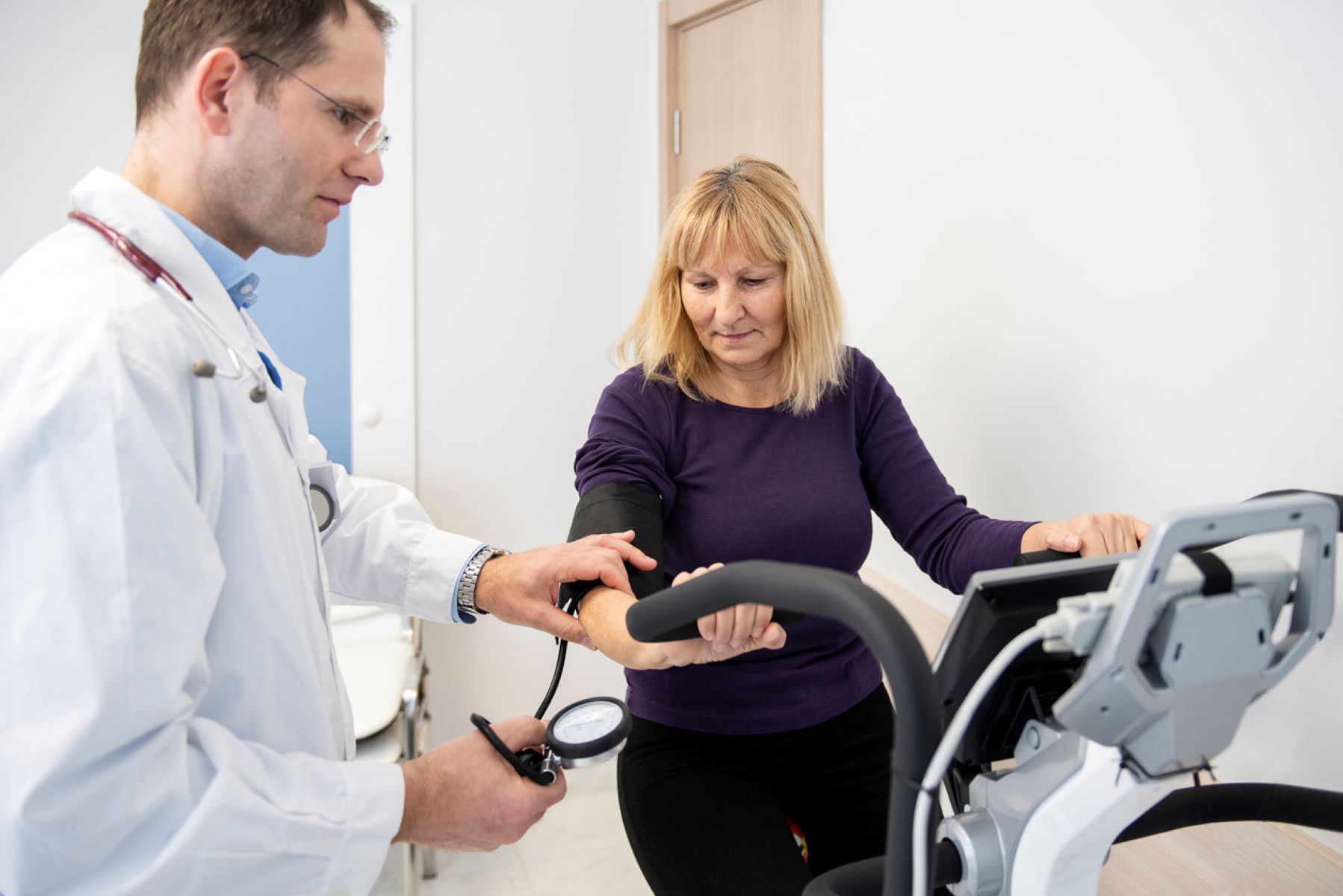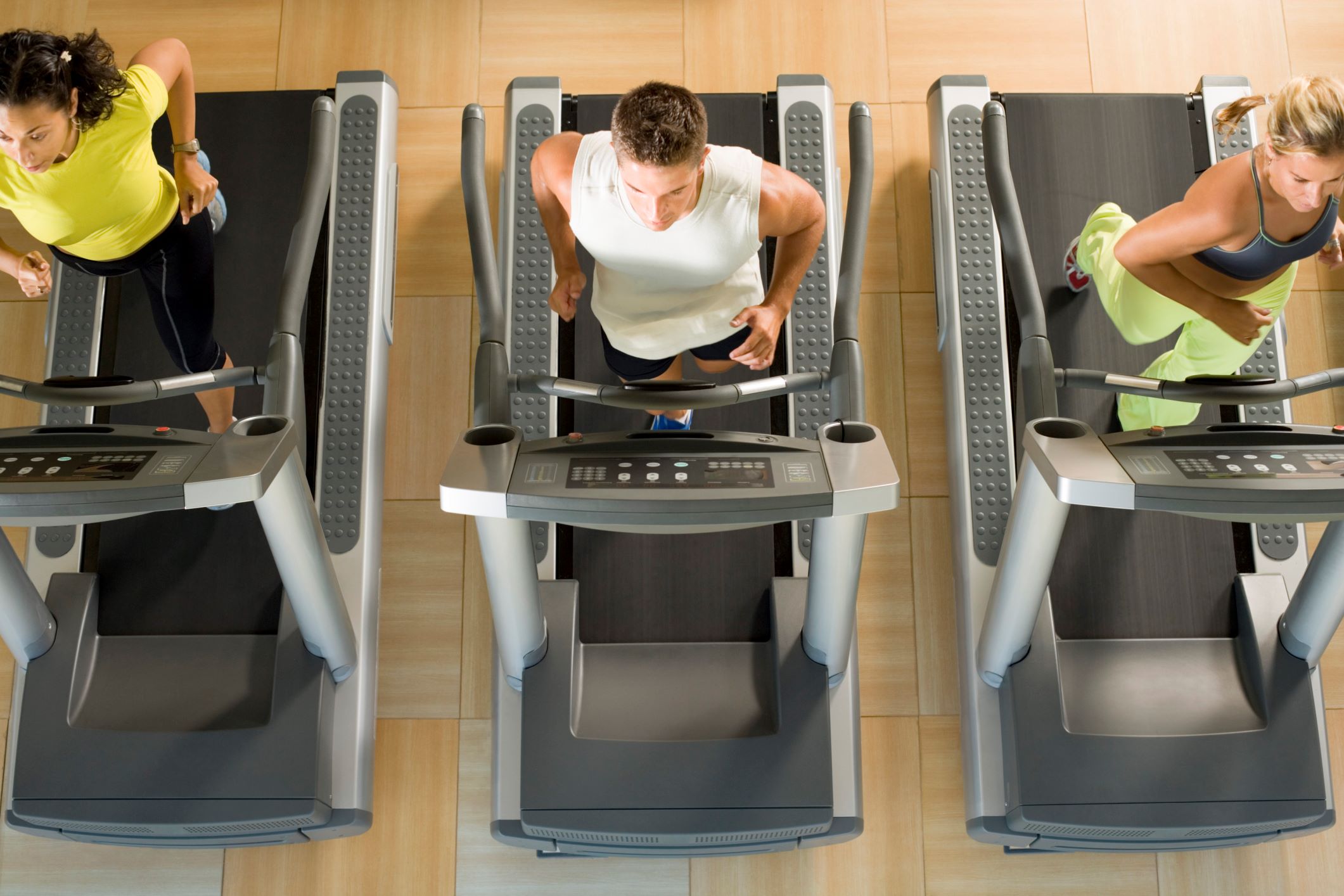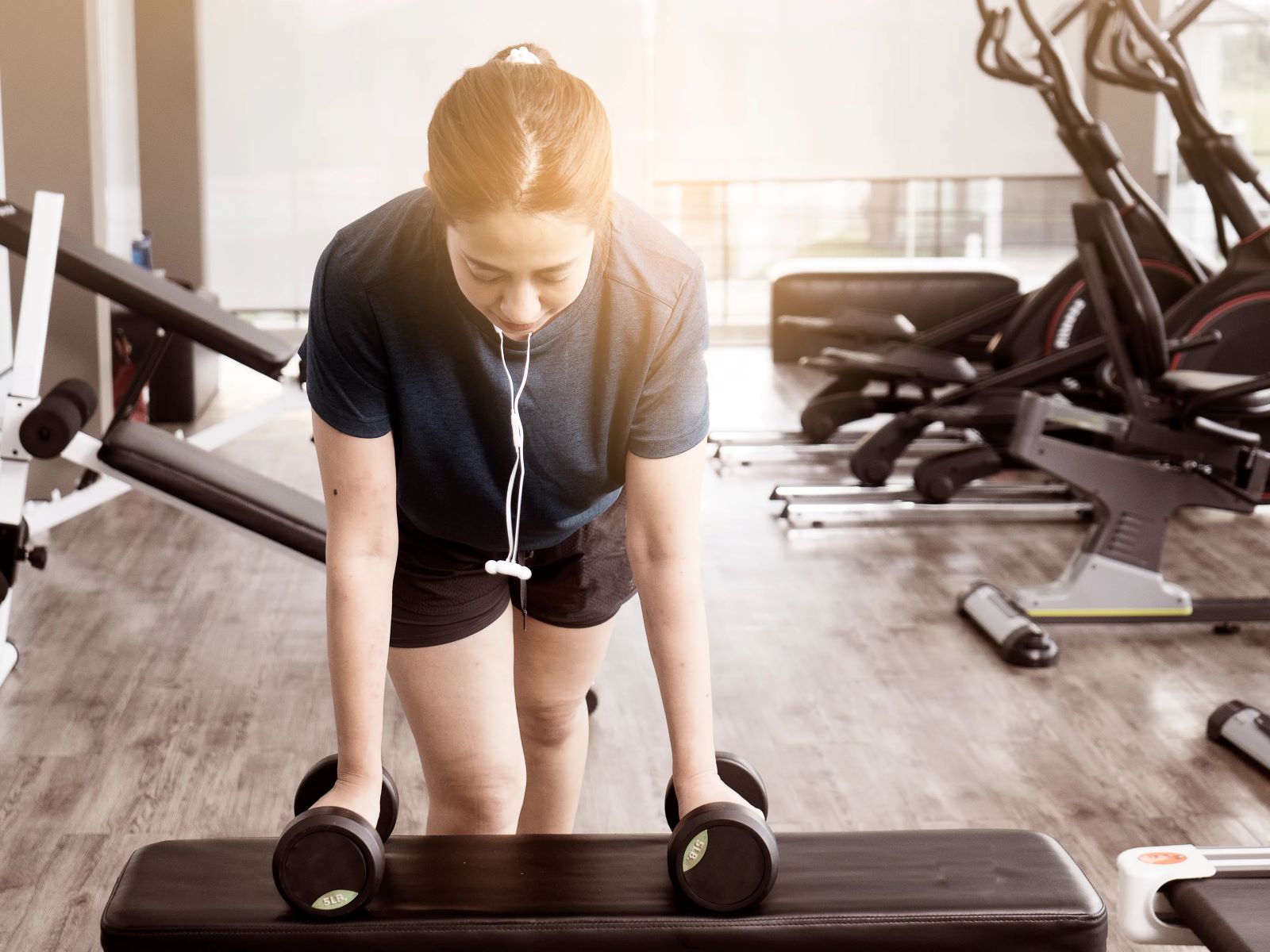

Featured
Why Do I Get Lightheaded When I Workout
Modified: August 22, 2023
Discover the reason behind feeling lightheaded during exercise and how to avoid it. Read our featured article on why you experience dizziness when working out.
Introduction
Have you ever experienced feeling lightheaded or dizzy during your workouts? It’s a common phenomenon that many people encounter, but it can be quite alarming if you’re not sure why it’s happening. Lightheadedness during exercise can range from a mild sensation of dizziness to a more severe feeling of almost fainting. While it may be tempting to brush it off as a normal part of the workout process, it’s essential to understand the underlying causes and how to prevent it.
Lightheadedness can occur during various types of exercises such as cardio workouts, weightlifting, or even during yoga sessions. It can happen to anyone, regardless of their fitness level or age. Understanding the reasons behind lightheadedness during workouts can help you take appropriate measures to prevent it and ensure a safer and more enjoyable fitness experience.
In this article, we will explore the common causes of lightheadedness during workouts and provide you with practical tips on how to prevent it. From hydration to proper breathing techniques, we’ll cover all the essentials to help you stay lightheadedness-free and get the most out of your workouts.
Understanding Lightheadedness during Workouts
Lightheadedness during workouts refers to a sensation of dizziness or feeling faint while engaging in physical activity. It can be a temporary and mild inconvenience or a more severe and prolonged issue that affects your ability to exercise safely. Understanding why lightheadedness occurs during workouts is crucial in order to take appropriate measures to prevent it.
During exercise, your body undergoes various physiological changes. Your heart rate increases, your blood vessels dilate, and your muscles demand more oxygen. These changes can sometimes disrupt the normal functioning of your body, leading to lightheadedness. It’s essential to identify the specific causes of lightheadedness during workouts to address them effectively.
While lightheadedness can have multiple underlying causes, some overarching factors contribute to this phenomenon. These include:
- Dehydration: Not consuming enough fluids before, during, or after your workout can result in dehydration. When your body lacks an adequate amount of water, blood volume decreases, leading to a drop in blood pressure. This can cause lightheadedness and dizziness.
- Low Blood Pressure: During exercise, your blood vessels dilate to allow for increased blood flow to your muscles. In some cases, this dilation can lead to a drop in blood pressure, resulting in lightheadedness.
- Hypoglycemia: Inadequate blood sugar levels can cause lightheadedness and dizziness during workouts. When your body doesn’t have enough glucose to fuel your muscles, it can result in symptoms of low blood sugar.
- Overexertion: Pushing your body beyond its limits and engaging in intense workouts without proper rest can lead to lightheadedness. Overexertion can cause a drop in blood pressure and a decrease in oxygen supply to the brain.
- Lack of Proper Breathing Technique: Improper breathing technique, such as holding your breath or shallow breathing, can disrupt the oxygen-carbon dioxide balance in your body. This can lead to lightheadedness and dizziness.
- Anxiety or Panic Attacks: Mental and emotional factors play a significant role in physical sensations. High levels of anxiety or experiencing a panic attack during workouts can trigger lightheadedness.
- Medication Side Effects: Certain medications, such as those used to treat high blood pressure or heart conditions, may have side effects that include lightheadedness during physical activity. It’s essential to consult with your healthcare provider if you suspect your medication is causing this symptom.
By understanding the common causes of lightheadedness during workouts, you can begin to take proactive steps to prevent this sensation. In the following sections, we’ll explore practical strategies to help you stay lightheadedness-free and make the most out of your exercise routine.
Causes of Lightheadedness during Workouts
Feeling lightheaded during workouts can be attributed to various factors related to your body’s response to physical activity. By understanding the specific causes, you can identify the root of the issue and take appropriate measures to prevent it in the future.
Dehydration: One of the most common causes of lightheadedness during workouts is dehydration. When you exercise, your body loses water through sweat, and if you don’t replenish it, you can become dehydrated. Dehydration leads to decreased blood volume, which in turn causes a drop in blood pressure. Low blood pressure can result in lightheadedness and dizziness.
Low Blood Pressure: Some individuals naturally have low blood pressure, and this can contribute to feeling lightheaded during workouts. During exercise, your blood vessels dilate to allow for increased blood flow, and if your blood pressure is already low, the additional dilation can exacerbate the drop in blood pressure, leading to lightheadedness.
Hypoglycemia: If your blood sugar levels are too low during exercise, you may experience lightheadedness. This is referred to as hypoglycemia. When your body doesn’t have enough glucose to fuel your muscles, it can lead to dizziness, weakness, and confusion.
Overexertion: Pushing your body too hard during workouts without giving it enough time to recover can result in lightheadedness. Overexertion places a significant strain on your cardiovascular system, causing a drop in blood pressure and a decrease in oxygen supply to the brain. It’s important to listen to your body and avoid overexertion by gradually increasing the intensity and duration of your workouts.
Lack of Proper Breathing Technique: Your breathing technique plays a crucial role in maintaining oxygen and carbon dioxide balance in your body. Improper breathing, such as holding your breath or shallow breathing, can disrupt this balance, causing lightheadedness during workouts. Focus on maintaining proper breathing patterns, inhaling deeply and exhaling fully.
Anxiety or Panic Attacks: Mental and emotional factors can also contribute to lightheadedness during workouts. High levels of anxiety or experiencing a panic attack can trigger lightheadedness. Stress and anxiety can lead to hyperventilation and changes in blood flow, resulting in dizziness and other symptoms.
Medication Side Effects: It’s important to note that certain medications may have side effects that include lightheadedness during physical activity. Medications used to treat conditions such as high blood pressure or heart problems can affect blood pressure levels and circulation, resulting in lightheadedness. If you suspect that your medication is causing this symptom, consult with your healthcare provider.
By understanding the specific causes of lightheadedness during workouts, you can take appropriate measures to prevent it. The next section will provide practical tips on how to avoid feeling lightheaded and ensure a safer and more enjoyable exercise experience.
Dehydration
Dehydration is a common cause of lightheadedness during workouts. When you exercise, your body loses water through sweat, and if you fail to replenish it, you can become dehydrated. Dehydration can lead to a decrease in blood volume, resulting in a drop in blood pressure and lightheadedness.
During physical activity, it’s essential to maintain adequate hydration to support optimal performance and prevent lightheadedness. Here are some key points to consider:
- Pre-workout Hydration: Start your workout well-hydrated by consuming water or non-caffeinated beverages before you exercise. Aim to drink at least 8 ounces of water 1-2 hours prior to your workout.
- During Workout Hydration: It’s important to drink water during your workout, especially if it lasts longer than an hour or if you’re exercising in a hot and humid environment. Take regular water breaks and listen to your body’s thirst cues.
- Post-workout Hydration: After your workout, replenish the fluids you’ve lost by drinking plenty of water. Hydrating adequately post-workout helps with recovery and prevents dehydration-related lightheadedness.
- Electrolyte Balance: When you sweat, not only do you lose water, but you also lose essential electrolytes such as sodium, potassium, and magnesium. These electrolytes play a crucial role in maintaining proper hydration and fluid balance in your body. Consider drinking sports drinks or incorporating electrolyte-rich foods like bananas or coconut water into your post-workout routine.
It’s important to note that individual hydration needs may vary depending on factors such as body size, duration and intensity of exercise, sweat rate, and environmental conditions. Listen to your body, and if you are unsure about your hydration status, consider consulting with a healthcare professional or a registered dietitian.
By prioritizing hydration before, during, and after your workouts, you can help prevent lightheadedness and maintain optimal physical performance. Make it a habit to carry a water bottle with you during your exercise sessions to ensure that you have easy access to hydration when needed.
Low Blood Pressure
Low blood pressure, also known as hypotension, can be a contributing factor to lightheadedness during workouts. During exercise, your blood vessels dilate to allow for increased blood flow to your muscles. While this is a normal response, individuals with naturally low blood pressure may experience a more pronounced drop in blood pressure, leading to lightheadedness.
Here are some key points to consider regarding low blood pressure and lightheadedness during workouts:
- Know Your Blood Pressure: If you consistently experience lightheadedness during exercise, it may be helpful to monitor your blood pressure. Check with your healthcare provider to ensure your blood pressure levels are within a healthy range.
- Stay Hydrated: Dehydration can exacerbate low blood pressure symptoms. Make sure you are adequately hydrated before and during your workouts to help maintain steady blood pressure levels.
- Gradual Warm-up and Cool-down: Start your workouts with a gentle warm-up and end with a cool-down period. These gradual transitions can help your body adjust and minimize any sudden drops in blood pressure.
- Avoid Sudden Changes in Position: When transitioning from lying or sitting to standing positions, do so slowly. This allows your body to adjust and prevent a sudden drop in blood pressure.
- Compression Clothing: Wearing compression socks or leggings can help improve blood flow and prevent blood pooling in the lower extremities, which can contribute to low blood pressure symptoms.
- Eat Balanced Meals: A well-balanced diet that includes foods rich in nutrients and minerals can help support optimal blood pressure levels. Include foods like whole grains, lean proteins, fruits, and vegetables in your diet.
- Consult with a Healthcare Provider: If lightheadedness during workouts persist or is accompanied by other concerning symptoms, it’s important to consult with a healthcare provider. They can assess your individual situation and provide personalized advice.
It’s important to note that low blood pressure can have various underlying causes, and it may require medical intervention to manage effectively. Your healthcare provider can provide guidance and recommend appropriate measures based on your specific situation.
By being mindful of your blood pressure and implementing these preventive measures, you can minimize the occurrence of lightheadedness during workouts and ensure a safer and more enjoyable exercise experience.
Hypoglycemia
Hypoglycemia, or low blood sugar levels, can be a common cause of lightheadedness during workouts. When your body doesn’t have enough glucose to fuel your muscles, it can lead to dizziness, weakness, confusion, and lightheadedness.
Here are some key points to consider regarding hypoglycemia and lightheadedness during workouts:
- Pre-workout Nutrition: It’s important to fuel your body with a balanced meal or snack before you exercise, especially if your workout is planned for an extended period. Focus on consuming a combination of carbohydrates, proteins, and healthy fats to provide a steady supply of energy to your muscles.
- Proper Time of Eating: Timing your meals and snacks can also play a role in preventing hypoglycemia during workouts. Try to eat 1-2 hours before exercising to allow your body enough time to digest and absorb the nutrients.
- Carbohydrate-rich Snacks: If you’re prone to hypoglycemia during workouts, consider having a small carbohydrate-rich snack, such as a piece of fruit or a granola bar, shortly before starting your exercise session. This can help boost your blood sugar levels and provide sustained energy.
- Blood Sugar Monitoring: Individuals who are susceptible to hypoglycemia may benefit from monitoring their blood sugar levels before, during, and after workouts. This can help identify any fluctuations and allow for timely interventions if needed.
- Post-workout Refueling: After your workout, replenish your glycogen stores by consuming a well-balanced meal or snack that includes carbohydrates and proteins. This will help restore your blood sugar levels and support muscle recovery.
- Consult with a Healthcare Provider: If you frequently experience hypoglycemia during workouts, it’s essential to consult with a healthcare provider to ensure there are no underlying medical conditions contributing to it. They can provide personalized recommendations and help develop a management plan.
It’s important to note that hypoglycemia can have various causes and may require medical intervention or changes in medication for individuals with specific health conditions like diabetes. If you have diabetes or a known medical condition that affects blood sugar levels, work closely with your healthcare team to manage your blood sugar levels during exercise.
By understanding the importance of proper pre-workout nutrition and monitoring your blood sugar levels, you can help prevent episodes of hypoglycemia and minimize lightheadedness during workouts, ensuring a safer and more enjoyable exercise experience.
Overexertion
Overexertion can be a significant cause of lightheadedness during workouts. Pushing your body beyond its limits without allowing for adequate rest and recovery can lead to a drop in blood pressure and a decrease in oxygen supply to the brain, resulting in lightheadedness.
Here are some key points to consider regarding overexertion and lightheadedness during workouts:
- Listen to Your Body: Pay attention to your body’s signals and avoid pushing yourself too hard. Respect your limits and gradually increase the intensity and duration of your workouts over time.
- Proper Warm-up and Cool-down: Before starting your workout, spend a few minutes engaging in a proper warm-up routine. This helps prepare your body for the physical exertion and reduces the risk of lightheadedness. Similarly, ending your workout with a cool-down allows your body to gradually transition back to a resting state.
- Rest and Recovery: Adequate rest and recovery are essential for preventing overexertion. Plan regular rest days and prioritize getting enough sleep to ensure your body has time to repair and rejuvenate.
- Progress Gradually: When increasing the intensity or duration of your workouts, do so gradually. Avoid abrupt changes that can place excessive stress on your body and increase the risk of lightheadedness. Set realistic goals and give your body the time it needs to adapt.
- Listen to Warning Signs: If you start experiencing symptoms of lightheadedness, dizziness, or fatigue during your workout, it’s crucial to listen to your body and take a break. Pushing through these symptoms can worsen the situation and potentially lead to injury.
- Vary Your Workouts: Incorporate a variety of exercises into your routine to avoid overexertion in specific muscle groups. This helps distribute the workload across different areas of your body and reduces the risk of strain or exhaustion.
- Seek Professional Guidance: If you’re unsure about the appropriate exercise intensity or need guidance on structuring your workouts, consider working with a certified personal trainer or exercise professional. They can help create a tailored program that takes into account your fitness level and goals.
Remember, fitness is a journey, and progress takes time. It’s important to find a balance between challenging yourself and allowing your body to recover. By practicing moderation and incorporating rest into your routine, you can help prevent overexertion-related lightheadedness and promote overall well-being.
Lack of Proper Breathing Technique
Lack of proper breathing technique during workouts can contribute to lightheadedness. Your breathing plays a crucial role in maintaining the balance of oxygen and carbon dioxide in your body. Improper breathing, such as holding your breath, shallow breathing, or irregular breathing patterns, can disrupt this balance and lead to feelings of lightheadedness and dizziness.
Here are some key points to consider regarding proper breathing technique during workouts:
- Focus on Deep Breathing: Practice deep breathing exercises to ensure adequate oxygen intake during your workouts. Breathe in deeply through your nose, filling your lungs, and then exhale fully through your mouth.
- Coordinate Your Breathing: Coordinate your breathing with your movements during exercise. For example, when lifting weights or performing resistance exercises, exhale during the effort or exertion phase and inhale during the relaxation phase.
- Avoid Breath Holding: It’s common for people to unconsciously hold their breath during challenging exercises. However, this can increase tension and disrupt the oxygen supply to your muscles and brain. Pay attention to your breathing and consciously avoid holding your breath.
- Practice Diaphragmatic Breathing: Diaphragmatic breathing, also known as belly breathing, involves using the diaphragm to take deep breaths rather than shallow chest breathing. Practice expanding your belly as you inhale and relaxing it as you exhale.
- Incorporate Breathing Breaks: During intense workouts, it can be helpful to take short breaks solely focused on breathing. Step away from your exercise routine, close your eyes, and take a few deep breaths to restore proper breathing patterns and reduce lightheadedness.
- Yoga and Meditation: Yoga and meditation practices often emphasize the importance of deep, intentional breathing. Consider incorporating these activities into your routine to improve your overall breathing technique and increase awareness of your breath.
- Stay Mindful: Throughout your workout, stay mindful of your breathing pattern. If you notice shallower or irregular breathing, take a moment to adjust and return to deep, rhythmic breathing.
Proper breathing techniques not only help prevent lightheadedness during workouts but also improve overall performance and focus. By incorporating these techniques into your exercise routine, you can optimize your breathing, enhance oxygen delivery to your muscles, and reduce the risk of lightheadedness or dizziness.
Anxiety or Panic Attacks
Anxiety or panic attacks can contribute to lightheadedness during workouts. Mental and emotional factors can have a significant impact on physical sensations, and high levels of anxiety or experiencing a panic attack can trigger feelings of lightheadedness or dizziness.
Here are some key points to consider regarding anxiety or panic attacks during workouts:
- Recognize and Acknowledge Your Anxiety: If you have a known history of anxiety or panic attacks, it’s important to recognize and acknowledge these symptoms. Understanding the role anxiety plays in your physical sensations can help you manage and prevent lightheadedness during workouts.
- Calm Your Mind: Prior to and during your workouts, take a few minutes to calm your mind. Engage in relaxation techniques such as deep breathing, meditation, or visualization exercises to help reduce anxiety levels. This can help prevent the onset of panic attacks during your workout.
- Implement Stress Reduction Techniques: Incorporate stress reduction techniques into your daily routine. Regular exercise, practicing mindfulness, getting enough sleep, and engaging in activities you enjoy can help reduce overall stress levels and manage anxiety.
- Track Your Triggers: Keep a journal to identify any patterns or triggers that contribute to your anxiety during workouts. It could be specific exercises, crowded environments, or certain time of the day. Understanding your triggers can help you develop strategies to minimize their impact.
- Gradual Exposure: If certain exercises or environments trigger anxiety or panic attacks, consider gradually exposing yourself to those situations. Start with less anxiety-provoking exercises or workout settings and gradually progress over time, building resilience and confidence.
- Seek Professional Help: If anxiety or panic attacks significantly impact your quality of life or hinder your ability to exercise, it may be beneficial to seek professional help. A therapist or counselor can provide strategies and support tailored to your specific needs.
- Exercise Buddy: Having a supportive workout partner can provide a sense of security and reassurance during workouts. They can help you stay accountable and provide comfort during moments of anxiety or panic.
It’s important to remember that managing anxiety and panic attacks is an ongoing process. If you find that your anxiety persists or worsens, seeking professional help is highly recommended to develop an appropriate treatment plan.
By implementing stress reduction techniques, gradually facing triggers, and seeking support when needed, you can better manage anxiety or panic attacks during workouts, reducing the likelihood of lightheadedness and creating a more enjoyable exercise experience.
Medication Side Effects
Medication side effects can be a potential cause of lightheadedness during workouts. Certain medications used to treat conditions such as high blood pressure, heart problems, or other medical conditions can have side effects that include lightheadedness during physical activity.
Here are some key points to consider regarding medication side effects and lightheadedness during workouts:
- Read the Medication Information: Familiarize yourself with the potential side effects of any medications you are taking. Pay attention to any warnings or precautions related to physical activity.
- Consult with Your Healthcare Provider: If you suspect that your medication is causing lightheadedness during workouts, it’s important to consult with your healthcare provider. They can review your medication regimen, evaluate your symptoms, and adjust your treatment plan if necessary.
- Timing of Medication: Discuss with your healthcare provider the timing of taking your medication in relation to your exercise routine. They may recommend adjusting the timing to minimize any potential side effects during workouts.
- Consider Alternative Options: In some cases, your healthcare provider may recommend alternative medications or treatment options with fewer side effects. It’s important to have an open and honest conversation with them to find the best solution for your specific situation.
- Moderate Exercise: If you experience lightheadedness due to the side effects of medication, consider engaging in moderate-intensity exercises that are less likely to trigger or exacerbate these symptoms. Low-impact activities like walking, swimming, or cycling can be suitable alternatives.
- Monitor Your Symptoms: Keep track of your symptoms and their frequency. It can be helpful to maintain a journal or log, including details about when the lightheadedness occurs and any accompanying symptoms. This information can provide valuable insights to share with your healthcare provider.
- Do Not Make Changes without Medical Guidance: Never stop or adjust your medication regimen without consulting your healthcare provider. Abruptly stopping or altering the dose of medication can have significant health implications. Always follow the guidance and recommendations of your medical professional.
It’s important to remember that medication side effects can vary from person to person. Everyone’s response to medication is different, and what may cause lightheadedness in one individual may not affect another in the same way. Your healthcare provider is the best resource for evaluating and managing medication-related lightheadedness during workouts.
By staying in close communication with your healthcare provider and following their guidance, you can address any medication side effects and ensure a safe and comfortable exercise experience.
Preventing Lightheadedness during Workouts
Experiencing lightheadedness during workouts can be concerning and disruptive to your exercise routine. Fortunately, there are several measures you can take to prevent lightheadedness and ensure a safer and more enjoyable fitness experience. Here are some key strategies to consider:
- Stay Hydrated: Dehydration can contribute to lightheadedness, so it’s crucial to maintain proper hydration before, during, and after exercise. Drink water regularly and consider incorporating electrolyte-rich fluids or foods into your routine to replenish essential minerals.
- Gradually Increase Intensity: Avoid overexertion by gradually increasing the intensity and duration of your workouts. Pushing your body too hard without sufficient rest can lead to lightheadedness. Listen to your body and respect your limits.
- Maintain Balanced Blood Sugar Levels: Proper nutrition is key to preventing lightheadedness. Eat a balanced meal or snack before exercise, including carbohydrates for energy and protein to sustain blood sugar levels. Monitor your blood sugar if necessary, especially if you have conditions like diabetes.
- Focus on Breathing Techniques: Practice deep and rhythmic breathing during your workouts. Avoid holding your breath and focus on inhaling through your nose and exhaling through your mouth. This will ensure optimal oxygen intake and promote relaxation.
- Manage Anxiety or Stress Levels: If anxiety or stress contribute to lightheadedness, incorporate stress-reduction techniques into your routine. Engage in activities like meditation, yoga, or mindfulness exercises to calm your mind and alleviate anxiety symptoms.
- Consult with a Healthcare Professional: If lightheadedness persists despite preventive measures, it’s crucial to consult with a healthcare professional. They can assess your individual situation, evaluate any underlying health conditions, and provide personalized recommendations.
Remember that prevention is the key to avoiding lightheadedness during workouts. By implementing these strategies and paying attention to your body’s signals, you can significantly reduce the risk of lightheadedness and ensure a more comfortable and effective exercise experience.
Stay Hydrated
Proper hydration is essential for preventing lightheadedness during workouts. When you exercise, your body loses water through sweat, and if you don’t replenish it, you can become dehydrated. Dehydration can lead to a decrease in blood volume, resulting in a drop in blood pressure and lightheadedness.
Here are some key strategies to help you stay hydrated during your workouts:
- Pre-Workout Hydration: Begin your workout well-hydrated by drinking water or non-caffeinated beverages before you start. Aim to consume about 8 ounces of water 1-2 hours before your workout.
- During Workout Hydration: It’s important to drink water during your workout, especially if it lasts longer than an hour or if you’re exercising in a hot and humid environment. Take regular water breaks and listen to your body’s thirst cues.
- Post-Workout Hydration: After your workout, rehydrate by drinking plenty of water. This helps replenish the fluids lost during exercise and promotes recovery.
- Electrolyte Balance: Along with water, your body also loses electrolytes such as sodium, potassium, and magnesium during exercise. Consider consuming sports drinks or incorporating electrolyte-rich foods like bananas or coconut water into your post-workout routine.
Individual hydration needs may vary depending on factors such as body size, duration and intensity of exercise, sweat rate, and environmental conditions. It’s important to listen to your body and adjust your hydration practices accordingly.
Carrying a water bottle with you during your workouts serves as a reminder to stay hydrated and ensures easy access to fluids. If you struggle with remembering to drink water, set reminders or find hydration apps that can help you stay on track.
It’s important to note that excessive hydration can also have negative consequences. Overhydration, known as hyponatremia, can dilute the sodium in your blood and lead to imbalances. Balance your hydration practices to ensure adequate fluid intake without overdoing it.
By prioritizing hydration before, during, and after your workouts, you can help prevent lightheadedness, support optimal performance, and maximize your exercise experience.
Gradually Increase Intensity
Gradually increasing the intensity of your workouts is essential for preventing lightheadedness and ensuring a safe and effective exercise experience. Pushing your body too hard without allowing for sufficient rest can lead to a drop in blood pressure and a decrease in oxygen supply to the brain, resulting in lightheadedness.
Here are some key strategies to help you gradually increase the intensity of your workouts:
- Set Realistic Goals: Start by setting realistic and achievable goals for your fitness journey. This allows you to take a systematic approach to progress while minimizing the risk of overexertion.
- Progress Slowly: Begin with low to moderate intensity exercises that match your current fitness level. Gradually increase the intensity by adding more repetitions, increasing weights, or extending workout duration over time.
- Allow for Adequate Rest: Rest and recovery are crucial for your body to adapt and make progress. Schedule regular rest days in your workout routine to prevent overexertion and optimize performance.
- Listen to Your Body: Pay attention to your body’s signals and respond accordingly. If you experience excessive fatigue, dizziness, or lightheadedness during or after a workout, it may be a sign that you’re pushing yourself too hard. Adjust the intensity or take extra rest days as needed.
- Track Your Progress: Keep a record of your workouts to track your progress over time. This will help you see improvements and ensure that you’re gradually increasing the intensity at a comfortable and sustainable pace.
- Incorporate Cross-training: Incorporate different types of exercises into your routine to avoid overexerting specific muscle groups. Cross-training helps distribute the workload across various areas of your body and reduces the risk of strain or exhaustion.
- Work with a Fitness Professional: If you’re unsure about how to progress or need guidance on structuring your workouts, consider seeking the help of a certified personal trainer or exercise professional. They can create a tailored exercise program that takes into account your fitness level, goals, and any specific limitations you may have.
Remember that progress takes time, and your body needs adequate time to adapt to increased intensity. Be patient and focus on steady, sustainable progress rather than rapid or drastic changes.
By gradually increasing the intensity of your workouts and listening to your body’s cues, you can prevent lightheadedness, reduce the risk of injury, and achieve long-term success in your fitness journey.
Maintain Balanced Blood Sugar Levels
Maintaining balanced blood sugar levels is crucial for preventing lightheadedness during workouts. Proper nutrition plays a vital role in supplying your body with the necessary energy to fuel your muscles and brain. When blood sugar levels drop too low, a condition known as hypoglycemia, it can lead to lightheadedness, weakness, and dizziness. Here are some key strategies to help you maintain balanced blood sugar levels during workouts:
- Pre-Workout Nutrition: Eat a balanced meal or snack before your workout, especially if it is longer in duration or higher in intensity. Include carbohydrates for energy and protein for sustained blood sugar levels.
- Timing of Meals and Snacks: Pay attention to the timing of your meals and snacks in relation to your exercise routine. Consuming a meal or snack 1-2 hours prior to exercise allows time for digestion and helps provide a steady source of energy.
- Carbohydrate-rich Snacks: If you are prone to experiencing hypoglycemia during workouts, consider having a small carbohydrate-rich snack, such as a piece of fruit or a granola bar, shortly before starting your exercise session. This can help boost your blood sugar levels and provide sustained energy.
- Blood Sugar Monitoring: If you have diabetes or are susceptible to hypoglycemia, consider monitoring your blood sugar levels before, during, and after your workouts. This can help you identify any fluctuations and take appropriate steps to maintain balanced blood sugar levels.
- Post-Workout Refueling: After your workout, replenish your glycogen stores by consuming a well-balanced meal or snack that includes carbohydrates and proteins. This helps restore your blood sugar levels and supports muscle recovery.
- Stay Consistent: Maintaining consistent eating patterns throughout the day can help stabilize blood sugar levels. Instead of skipping meals or going for long periods without eating, aim for regular and balanced meals and snacks.
- Monitor Your Symptoms: Pay attention to how your body feels during your workouts. Be mindful of any symptoms of hypoglycemia, such as lightheadedness, weakness, or confusion. If you experience these symptoms, stop exercising and address your blood sugar levels immediately.
It’s important to note that individual nutrition needs may vary, especially for those with specific health conditions such as diabetes. Consulting with a healthcare professional or registered dietitian can help you develop a personalized nutrition plan that supports stable blood sugar levels during exercise.
By prioritizing proper pre-workout nutrition, monitoring blood sugar levels, and refueling appropriately, you can maintain balanced blood sugar levels during workouts, prevent lightheadedness, and optimize your exercise performance.
Focus on Breathing Techniques
Focusing on proper breathing techniques during workouts is essential for preventing lightheadedness and enhancing your overall exercise experience. Your breath plays a crucial role in supplying oxygen to your muscles and organs, and improper breathing can disrupt this balance, leading to lightheadedness and dizziness. Here are some key strategies to help you maintain proper breathing techniques during workouts:
- Deep Breathing: Practice deep breathing exercises to ensure adequate oxygen intake during your workouts. Breathe in deeply through your nose, filling your lungs, and then exhale fully through your mouth. This helps oxygenate your muscles, increase relaxation, and prevent lightheadedness.
- Coordinate Your Breathing: Coordinate your breath with your movements during exercise. For example, when lifting weights or performing resistance exercises, exhale during the exertion phase and inhale during the relaxation phase. This helps stabilize your core, provide stability, and optimize oxygen flow.
- Avoid Breath Holding: Holding your breath during exercise can restrict oxygen flow and increase tension. Avoid breath-holding and focus on maintaining a constant and rhythmic breathing pattern. This helps ensure a continuous supply of oxygen to your muscles and reduces the risk of lightheadedness.
- Diaphragmatic Breathing: Practice diaphragmatic breathing, also known as belly breathing. Breathe deeply into your abdomen, allowing your diaphragm to expand, rather than shallow chest breathing. This type of breathing enables efficient oxygen exchange and promotes relaxation.
- Incorporate Breathing Breaks: During intense workouts, take short breaks solely focused on conscious breathing. Step aside from your exercise routine, close your eyes, and take a few slow and deep breaths. This helps restore proper breathing patterns, reduce stress, and prevent lightheadedness.
- Yoga and Mindfulness: Consider incorporating activities such as yoga or mindfulness meditation into your routine. These practices emphasize the importance of breath awareness and focus, helping you develop better control over your breathing during exercise.
Staying mindful of your breathing patterns during workouts not only prevents lightheadedness but also enhances your mind-body connection and helps optimize physical performance. It may take practice and conscious effort to develop good breathing habits, but the benefits are well worth it.
Remember to pay attention to your breath throughout your workouts, ensuring deep, rhythmic breathing. By maintaining proper breathing techniques, you can increase oxygen uptake, reduce lightheadedness, and enhance your overall exercise experience.
Manage Anxiety or Stress Levels
Managing anxiety or stress levels is crucial for preventing lightheadedness during workouts. Mental and emotional factors can significantly impact physical sensations, and high levels of anxiety or experiencing a panic attack can trigger feelings of lightheadedness or dizziness. Here are some key strategies to help you manage anxiety or stress levels during workouts:
- Recognize and Acknowledge Your Anxiety: If you have a known history of anxiety or experience high levels of stress, it’s important to recognize and acknowledge these symptoms. Being aware of your anxiety allows you to take proactive steps to manage it.
- Calm Your Mind: Prior to and during your workouts, take a few minutes to calm your mind. Engage in relaxation techniques such as deep breathing, meditation, or visualization exercises. This can help reduce anxiety levels and promote a sense of calm.
- Implement Stress Reduction Techniques: Incorporate stress reduction techniques into your daily routine. Regular exercise, practicing mindfulness or meditation, getting enough sleep, and engaging in activities you enjoy can help reduce overall stress levels and manage anxiety.
- Identify Triggers: Keep a journal to identify any patterns or triggers that contribute to your anxiety during workouts. It could be specific exercises, crowded environments, or certain times of the day. Understanding your triggers can help you develop strategies to minimize their impact.
- Gradual Exposure: If certain exercises or environments trigger anxiety or panic attacks, consider gradually exposing yourself to those situations. Start with less anxiety-provoking exercises or workout settings and gradually increase the difficulty over time. This helps build resilience and confidence.
- Seek Professional Help: If anxiety or panic attacks significantly impact your quality of life or hinder your ability to exercise, it may be beneficial to seek professional help. A therapist or counselor can provide strategies and support tailored to your specific needs.
- Exercise Buddy: Having a supportive workout partner can provide a sense of security and reassurance during workouts. They can help you stay accountable, provide comfort during moments of anxiety or panic, and make your workouts more enjoyable.
It’s important to remember that managing anxiety and stress is an ongoing process. Implementing these strategies may require consistency and patience. If you find that your anxiety persists or worsens, seeking professional help is highly recommended to develop an appropriate treatment plan.
By incorporating stress reduction techniques, gradually facing triggers, and seeking support when needed, you can better manage anxiety or panic attacks during workouts, reducing the likelihood of lightheadedness and creating a more enjoyable exercise experience.
Consult with a Healthcare Professional
If you frequently experience lightheadedness during workouts despite implementing preventive measures, it’s important to consult with a healthcare professional. They can assess your individual situation, evaluate any underlying health conditions, and provide personalized recommendations to address the issue.
Here are some key reasons why consulting with a healthcare professional is important:
- Accurate Diagnosis: A healthcare professional can conduct a thorough evaluation, review your medical history, and perform any necessary tests to diagnose any underlying conditions that may be contributing to your lightheadedness.
- Individualized Recommendations: They can provide personalized recommendations tailored to your specific needs and health condition, taking into account factors such as medication use, medical history, and any existing health concerns.
- Medication Review: If you’re taking medications, a healthcare professional can review your current regimen and assess whether any prescriptions may be contributing to your lightheadedness. They can adjust dosages or explore alternative options to minimize unwanted side effects.
- Management of Underlying Medical Conditions: If underlying medical conditions, such as cardiovascular issues or hypoglycemia, are contributing to your lightheadedness, a healthcare professional can develop a comprehensive management plan to address these conditions and prevent further complications.
- Additional Testing: Depending on your symptoms and health history, a healthcare professional may recommend further diagnostic tests to identify any underlying causes of your lightheadedness. These tests may include blood work, imaging studies, or specialized evaluations.
- Expert Guidance: A healthcare professional has the knowledge and expertise to provide guidance on exercise modifications, nutritional adjustments, and lifestyle changes that can help alleviate lightheadedness and improve your overall well-being.
- Peace of Mind: Consulting with a healthcare professional can provide peace of mind by allowing you to address your concerns and receive proper medical guidance. It eliminates the guesswork and helps ensure that you’re taking the necessary steps to optimize your health and fitness.
Remember that healthcare professionals are there to support you on your fitness journey. If your lightheadedness persists or worsens, don’t hesitate to reach out and schedule an appointment with a qualified healthcare professional who can provide accurate guidance and help you navigate your specific health concerns.
Conclusion
Lightheadedness during workouts can be alarming and disrupt your exercise routine. However, by understanding the common causes and implementing preventive strategies, you can minimize the occurrence of lightheadedness and ensure a safer and more enjoyable fitness experience.
Key preventive measures include staying hydrated, gradually increasing the intensity of your workouts, maintaining balanced blood sugar levels through proper nutrition, focusing on proper breathing techniques, managing anxiety or stress levels, and consulting with a healthcare professional if needed.
Remember that each person’s experience with lightheadedness may be unique, and it’s important to listen to your body and seek appropriate medical advice if symptoms persist or worsen. Working with healthcare professionals can provide personalized recommendations based on your specific needs and help address any underlying health conditions that may contribute to lightheadedness.
By paying attention to your body, implementing preventive strategies, and seeking professional guidance when necessary, you can optimize your workouts, minimize lightheadedness, and enjoy the numerous physical and mental benefits that regular exercise brings. Prioritizing your health and well-being will ensure a fulfilling and sustainable fitness journey.
